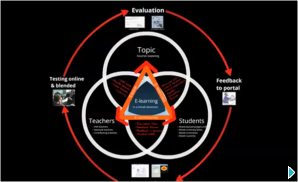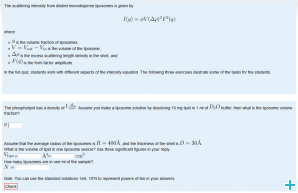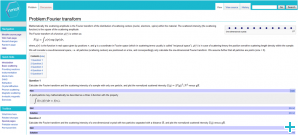Learning for free, online: Virtual Neutrons for Teaching
An e-learning platform on neutron scattering techniques
By Inês Crespo, 07/11/2013
NEW 09/03/2016: the e-learning platform is now online at e-neutrons-org.
Neutron scattering techniques have proved their value in investigating the structure and properties of a wide range of materials. Although neutron experiments could therefore be of benefit to scientists from many different fields of research, neutron scattering is not regularly featured on the curriculum of university Master's courses, remaining unknown to many students to whom it could be a useful technique.
Even though a number of specialised schools provide training in this field (such as the ones supported by NMI3 ), participation in practical courses is often limited to a small number of students. For this reason NMI3 has decided to support a joint initiative by the University of Copenhagen, the Technical University of Denmark, the Technical University of Munich, and the Institut Laue-Langevin to develop an e-learning platform on neutron scattering.
Linda Udby is a Post-Doc researcher on neutron scattering at the University of Copenhagen and the leader of this project. The idea for this online portal came up while she was involved in the creation of a neutron scattering wiki as part of the NMI3’s previous phase of funding. She and her team felt that their work could be pursued and that it would be useful to develop an online platform for learning.
Their goal is to create a single portal with three components:
- a wiki book with theoretical learning material on neutron scattering and interactive exercises
- simulations of experiments
- quiz-lessons
I visited the team responsible for the project at the Niels Bohr Institute (NBI) of the University of Copenhagen to learn all about this very interesting initiative called Virtual Neutrons for Teaching (VNT).
Three-in-one: theory, exercises and practicals
Pia Jensen is a PhD student at the University of Copenhagen with an interest in computer programming; part of her work is on the e-learning platform. Her role is to develop a series of plug-ins that make it easier to read through the wiki-pages of the VNT. She is also in charge of transferring lecture notes on neutron scattering to the platform.
Pia showed me what the e-learning platform will look like. The wiki page, exercises and simulations, which now all exist separately, will be integrated into a single e-learning platform. Pia is making sure that the wiki pages with theoretical information about neutron scattering are as user-friendly as possible. Browsing through the pages is very intuitive and the chapters are linked so that you can easily find the information you are looking for as well as the respective references. As for the exercises, Pia has already used them in the classroom. She is one of the teachers of a course attracting a high number of students and sometimes she is alone with the class, so she thought it would be helpful if her students could receive feedback directly from their computers. The e-learning exercises give tips on how to solve an exercise when students cannot find their way to the solution. If the first tip is not enough, they are given a second one. At the end of the exercise, the programme tells them whether their solution is right or wrong and explains why. According to Pia this tool has really optimised the time she needs to devote to each student. Moreover such interactive exercises are very stimulating for the students and a fun way to learn. On VNT this interactivity is built into all the different exercises – quizzes, equations, open questions, identifying elements on a figure…
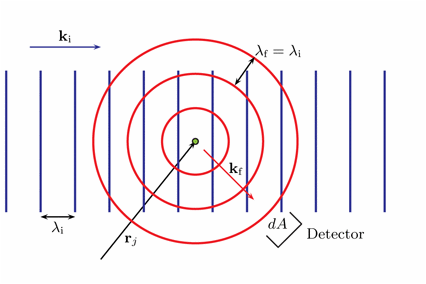
One of the VNT's animations.
Pia also showed me the Live Simulation pages where neutron instruments can be built from scratch or samples analysed. Peter Willendrup and Kim Lefmann work on the open-source McStas software used for simulating neutron scattering instruments. Peter is from the Technical University of Denmark; he is in charge of developing McStas and maintaining its website and mailing list. Kim is an associate professor in neutron scattering at the University of Copenhagen and his main role in the project is the scientific and educational use of the program. Together with a team from across Europe, Peter Willendrup has been working for many years on the McStas software and is now developing a technical solution to allow McStas simulations to be performed on the VNT portal.
Kim Lefmann has used these simulations for teaching the neutron scattering course in Copenhagen since its beginning in 2005 and the results are very positive. In his Master's class in physics Kim covers the theoretical background and then provides the software to his students so that they can build up a neutron scattering instrument from scratch. The exercises are very challenging and provide a hands-on experience of every component in the instrument, helping to understand the function of each tool. We can assemble instruments part-by-part (e.g. a guide, a detector, a sample, etc), testing different angles and tools, while sitting at the computer. These simulations make it possible to “play” with instruments in a way that would be impossible with real hardware.
It is also possible to go further and simulate an experiment where a sample is analysed by a neutron scattering instrument. A number of instruments are described and schematically represented. Once a series of parameters have been set, the simulation passes the neutron beam through the sample and provides the output at the instrument's detector. The software also offers the possibility of seeing an instrument in 3D and taking a virtual tour of the neutron guide. The results obtained can then be visualised in a graph and analysed as logarithmic data. The data can be downloaded and then compared to the outcome of a real neutron scattering experiment.
Neutron scattering experiments – evidence of success
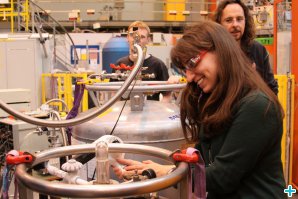
After building a Cold Neutron Powder Diffractometer with a simulation software, students feel more confortable when they go to PSI for experiments.
Whilst in Copenhagen I had the chance to meet some of the students who have used the e-learning portal for their Master's course. They told me that the system had definitely helped them to learn about neutron scattering. One of the advantages noted was the immediate feedback they receive when doing an exercise, compared to traditional assignments. This helped them to better understand the steps to be taken towards the right solution. For the majority of the students, these simulations were the first time they had ever “seen” a neutron scattering experiment. The software offered a flexible way of building and understanding an instrument, as they could start with simple segments and slowly make it more complex.
To finalise their course, these students go to the Paul Scherrer Institute (PSI) in Switzerland to perform experiments based on their recent training. According to the professors and instrument scientists, it is clear that the students understand the experiments much better because they have used the simulations before going to PSI.
Students’ interaction with the platform – didactics research
The team is continuously working on improving VNT. There is currently little research on how users interact with this type of e-learning portal. Jesper Bruun, a PostDoc researcher on physics education research at the University of Copenhagen, is investigating precisely this interaction. Being a didactics researcher with a background in physics makes him the perfect person to work on the VNT platform. His role on the project is two-fold; he explores the portal’s design to assure that the exercises address the difficulties faced when learning neutron scattering techniques; and he investigates possible ways to measure students’ interactivity with the e-learning platform. The ultimate goal of Jesper’s research is ambitious – to predict how students reason about a given exercise on the basis of how they perform it.
To investigate the students’ interaction with the software, Jesper monitors their moves while they solve an exercise, such as where they click, the answers they select, the steps they take before reaching a solution, what they learned from it. The next step will be to video-record the students, to be able to see where they look while using the VNT. By monitoring all these aspects, he has identified a number of patterns for how students interact with the software, which will help to enhance the e-learning portal. For instance, students may forget to include a relevant factor in a scattering intensity equation and this will result in an answer that is wrong in a predictable way. Jesper has identified these types of “distractions” and could consequently re-design the exercises accordingly, to warn the students about the mistake. Another example is an exercise where students see an image of a liposome and need to identify the hydrophobic and hydrophilic areas. Jesper has investigated whether it is possible to use interactivity in this exercise, for instance by providing brief explanations about the subject that could help solve the problem. New exercises on other topics such as crystallography are currently being developed.
The advantages of an e-learning portal on neutron scattering
Linda Udby told me that she has “the dream of online accessible education so that people who need to learn neutron scattering, but cannot attend a regular course, can educate themselves at home”. In many countries, resources to attend specialised courses are limited, as these courses may involve travelling and registration fees. With the VNT online portal anyone from any point of the globe will be able to learn about neutron scattering free of charge.
For the ones who do have the possibility of enrolling on a university course on neutron scattering, this e-learning platform can be a supplement for blended learning. On the one hand, teachers may use the e-learning platform to pass the information on to their students, thus greatly optimising the time devoted to each student. On the other hand, students can complement what they learn from their teachers with further material and exercises. This is not a new format. Some of the most important universities in the world already use online platforms to deliver part of the courses’ content to students.
Furthermore, not every country has a neutron source and scientists often need to travel to distant neutron facilities to have their samples analysed. The whole process of applying for beam-time, reviewing proposals, and finally visiting a neutron source can be rather long, leaving little time for scientists with no background on the subject to learn about it. This e-learning platform will give students and researchers who are interested in understanding what happens inside a neutron instrument the opportunity to view simulations of a range of neutron scattering experiments while sitting at the computer. The platform may also be used in neutron facilities worldwide. Many of the users who come to perform experiments have no background in neutron scattering. The possibility of having previous access to VNT, which actually lets them operate virtual neutron instruments, will definitely enhance their experience at neutron facilities.
Last, by having all this material online rather than in a text book, it is possible to constantly renew and update the content so that users can have access to the most recent scientific information. In addition, a number of online features make it possible to browse through the content in an easy, fast, and intuitive way.
Invitation to collaborate
The actual material published on VNT is fruit of on-going collaborations with scientists, neutron facilities and universities who are contributing with lecture notes. The aim is for the portal to be of value to universities and facilities alike. Everyone is invited to contribute with material from e.g. summer schools (contact Jürgen Neuhaus) or join in the development of this e-learning portal (contact Linda Udby).
Given that the project was only born 1.5 years ago, it is still in an early phase of research and development. Neutron facilities continue to build new tools for neutron scattering and this project is following suit, developing new programmes and tools to solve equations and new simulations. While some of these facilities are already available online, the team still has some months of work ahead until the VNT portal is complete. It will certainly be worth waiting for!
Useful links
NMI3 thanks the e-learning team and the ILL Translation office.
